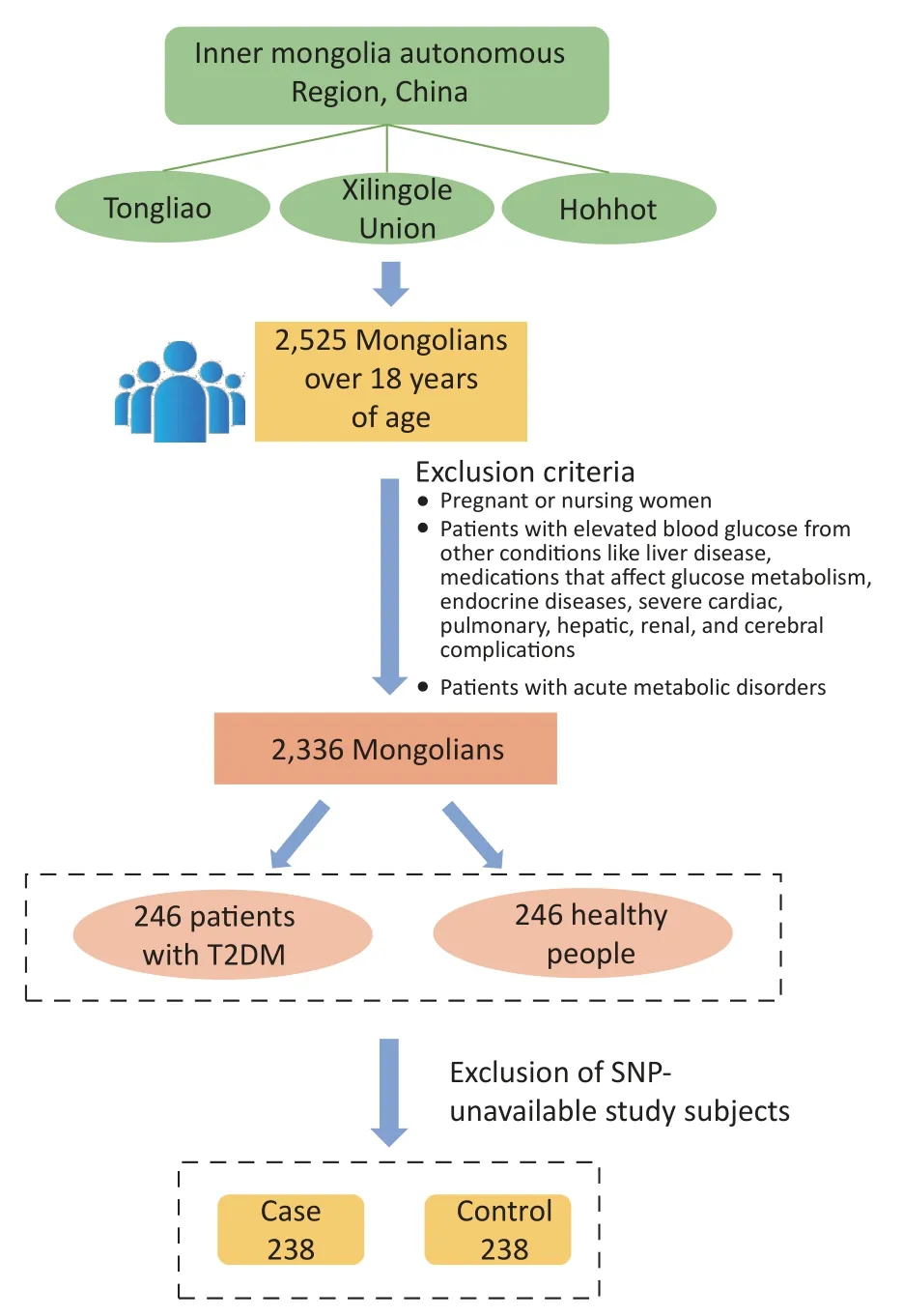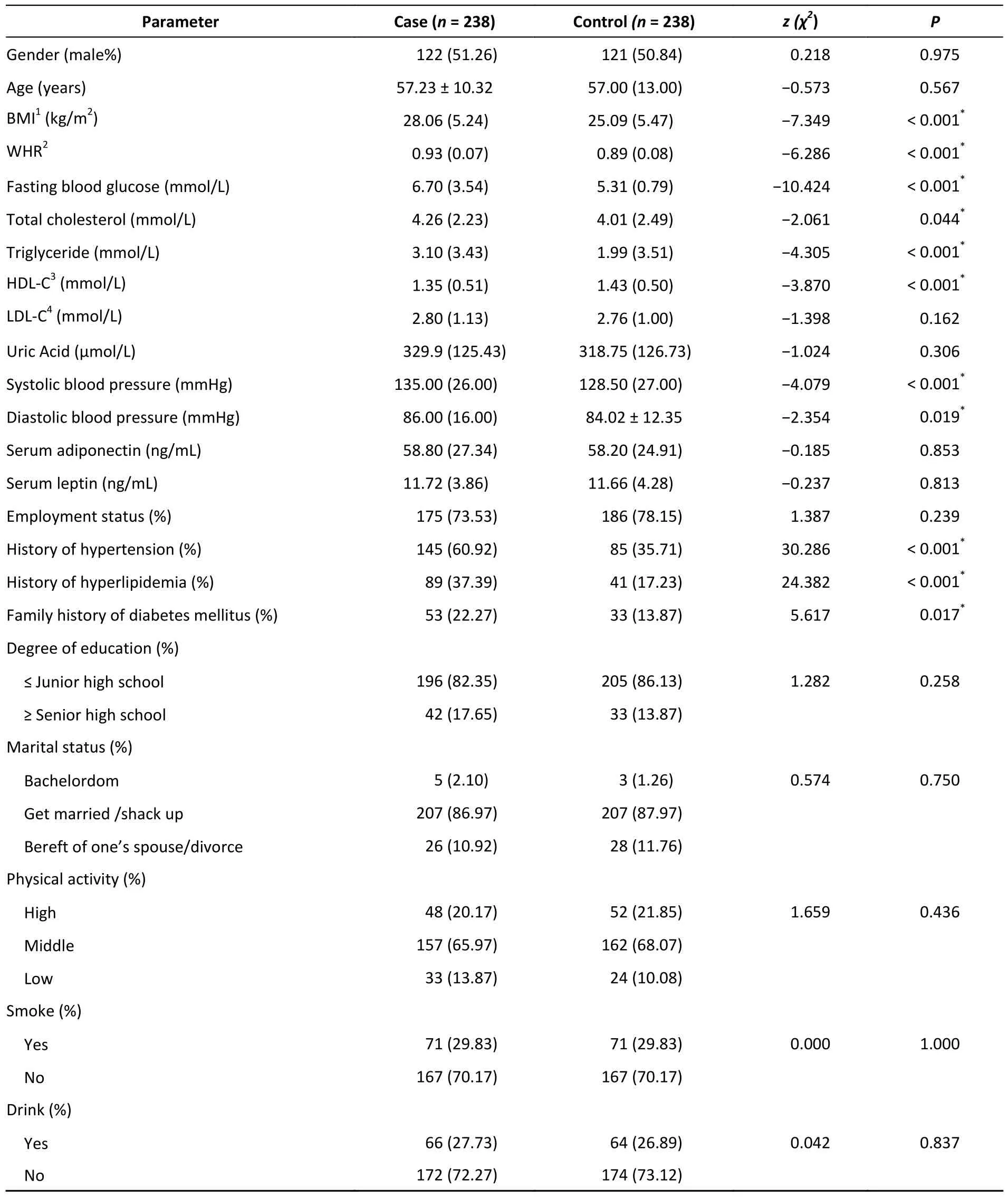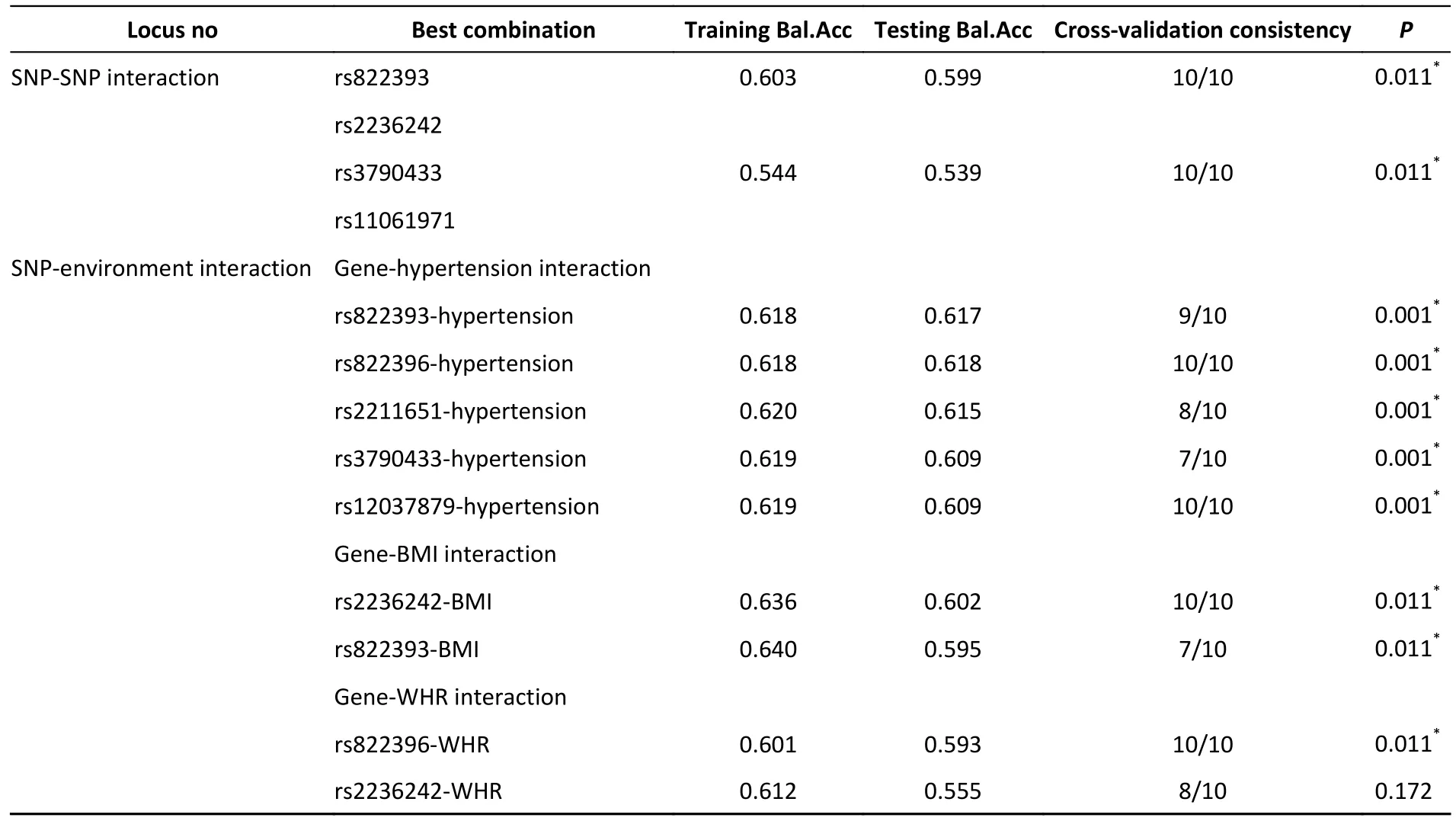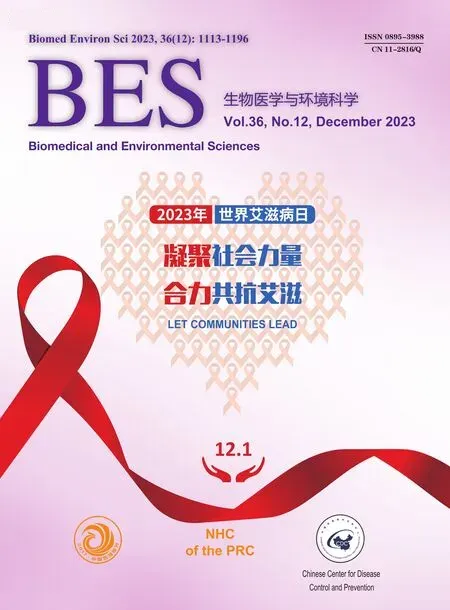Adipocytokine Gene SNPs and Type 2 Diabetes in Mongolians:A Gene-Gene and Gene-Environment lnteraction Study*
LI Na, ZHANG Li Hong, GAO Yu Min, LI Hai Ling, LI Wu Yun Ta Na, PANG Hui,ZHAO Yan Ping, ZHENG Hai Fang, DONG Jia Hui, and ZHAO Ling Yan,#
The International Diabetes Federation’s most recent data indicates that the prevalence of diabetes worldwide is projected to rise to 12.2% by 2025, with 783 million people affected[1].The prevalence of diabetes in China has risen from 9.3% in 2011 to 13.04% in 2021[1].A cross-sectional study in China showed that the prevalence of diabetes among Tibetans was 6.5% and it was 6.3% among the Hui people in 2018, while the incidence of diabetes in the Inner Mongolia Autonomous Region was as high as 19.9%, ranking first in the country[2].The Mongolian population has a diet structured around meat and milk, supplemented by pasta, rice and vegetables, and foods such as homemade yogurt and bacon are often consumed.Such a unique diet may have contributed to a high incidence of diabetes among the Mongolian people.
Adipocytokines are bioactive substances that are secreted by adipose tissue and frequently play a role in disorders associated with obesity.Adiponectin, leptin, and other adipocytokines are significantly altered in obese type 2 diabetes mellitus (T2DM) patients.The adiponectin gene(ADIPOQ), which is located on chromosome 3Q27,encodes the adipocytokine adiponectin.Vaspin is a novel adipocytokine associated with obesity,glucose regulation, and insulin resistance.Serum vaspin levels were found to be elevated in patients with T2DM compared to healthy controls[3].Leptin is a hormone that is mainly secreted by fat cells and increased leptin levels have been linked to the development of T2DM and insulin resistance[4].Additionally, high genetic heterogeneity is a characteristic of T2DM[2].Previous research showed that T2DM in the Mongolian population was correlated with polymorphisms in the ADIPOQ and leptin receptor (LEPR) genes.In a study of Han Chinese people, it was found that the single nucleotide polymorphism (SNP) rs2236242 in the vaspin gene (VASPIN) is associated with obesity and T2DM[5].Finding the genetic and environmental causes of T2DM and understanding the possible etiology behind these causes may inspire fresh approaches in the treatment and prevention of the disease.However, the associations of SNPs in ADIPOQ, adiponectin receptor 2 gene (ADIPOR2), LEPR, and VASPIN with environmental factors in patients with T2DM remain to be fully clarified.The purpose of this study was to ascertain whether environmental variables, T2DM, and ADIPOQ, ADIPOR2, LEPR, and VASPIN SNPs in Mongolians are related.Additionally, gene-gene and gene-environment interactions.
The study population was chosen from participants in a preliminary cross-sectional survey.Using multistage whole-cluster random sampling by population proportion, we conducted on-site epidemiologic surveys on the Mongolian populations in Tongliao, Xilingole Union, and Hohhot, in the Inner Mongolia Autonomous Region, from 2018 to 2020,and the current study focused on T2DM patients within the study population.Using the method of frequency matching, healthy people were selected as a control group in the cross-sectional survey population based on the condition of similar age ratio and sex ratio to the case group.The sample size was calculated by referring to the case-control sample size formula:whereα= 0.05,β= 0.1.A query of PubMed showed that in the SNPs selected for study, the smallest minimal allele frequency is the SNP locus rs822393 of ADIPOQ at 0.369, which givesP0= 0.369 and an odds ratio (OR) = 1.84, from which the sample size is calculated[6].The sample size for this case-control study was calculated as 231 cases in the case and control groups, respectively.In the final analysis, 238 patients with T2DM and 238 healthy controls were included, with an age range of 26–80 years (57.20 ±10.25) in the case group and 27–80 years [57.00(13.00)] in the control group (Figure 1).All subjects signed an informed consent form prior to enrollment.
The questionnaires covered general demographics, family history, life behavioral patterns and other items.Blood samples were used to measure fasting blood glucose, total cholesterol(TC), triglycerides (TG), high-density lipoprotein cholesterol (HDL-C), and low-density lipoprotein cholesterol (LDL-C).Serum leptin and adiponectin levels were measured by enzyme-linked immunosorbent assays commissioned by SinoBest Bio (Shanghai, China).

Figure 1.The flowchart of the study sample.
Genomic DNA was isolated from the blood samples using a Blood Genome DNA Extraction Kit (TIANGEN Bio Company, Beijing, China),following the manufacturer’s instructions.To assess the quality, DNA concentrations and purity were measured using ultraviolet-visible spectrophotometry (NanoDrop 2000c Spectrophotometer; Thermo Fisher Scientific,Wilmington, DE, USA), with ultrapure water used as a negative control.
By adding 2,000 bp to the 3' and 5' ends of the genes, the data for the genes were retrieved using the public 1,000 Genomes database.The gene Tag SNPs were obtained by Haploview software (version 4.2; Broad Institute of MIT and Harvard) by setting the following selection criteria: minimum allele frequency > 0.05 and linkage disequilibriumr2> 0.8.The PubMed database was searched for studies on ADIPOQ, ADIPOR2, LEPR, and VASPIN gene polymorphisms and T2DM.Combining the results of the literature search, eight loci were screened in this study, including ADIPOQ (rs822396, rs822393,rs10937273), ADIPOR2 (rs11061971), LEPR(rs2211651, rs3790433, rs12037879), and VASPIN(rs2236242).
PCR amplification primers and multiple singlebase extension primers were designed by Genesky Biotechnologies Inc.(Shanghai, China) as shown in Supplementary Table S1 (available in www.besjournal.com), and multiple high-temperature ligase detection reaction technology was used for genotyping experiments.The collected original data were analyzed by GeneMapper 4.1 software(Applied Biosystems, Foster City, CA, USA).
For this study, we used SPSS 25.0 software (IBM,New York, NY, USA) to conduct the statistical analyses.Values ofP< 0.05 were considered statistically significant.The associations between genotype frequency and loci in the dominant and stealth models and T2DM were evaluated by multiple logistic regression analysis.Haploview software was used to determine the Hardy-Weinberg equilibrium (HWE), linkage disequilibrium(LD), and haplotype of the gene loci.We screened the best gene-gene and gene-environment interaction patterns by generalized multifactor dimensionality reduction (GMDR).The optimal model with maximum cross-consistency was selected.
The biochemical and basic demographic characteristics of the 238 patients and 238 healthy controls are shown in Table 1.Compared with the healthy controls, the T2DM patients had higher body mass index (BMI), waist-to-hip ratio (WHR), fasting blood glucose, TC, TG, systolic blood pressure, and diastolic blood pressure, but lower HDL-C (P< 0.05).Patients with a history of hypertension and hyperlipidemia and a family history of diabetes weremore frequent in the patient group compared with the healthy control group (P< 0.05).

Table 1.General characteristics of the study subjects
As shown in Supplementary Table S2 (available in www.besjournal.com), the eight SNPs in the two groups basically met HWE (P> 0.05).As in Supplementary Table S3 (available in www.besjournal.com), allele frequencies at the gene loci did not differ statistically significantly between the two groups (P> 0.05).The relationship between T2DM and the SNPs in ADIPOQ, VASPIN, LEPR, and ADIPOR2 was examined using dominant and invisible models of the genes.There were no significant relationships between the genetic patterns and T2DM (Supplementary Table S4, available in www.besjournal.com).
The LD between rs3790433 and rs12037879 and between rs10937273, rs822396, and rs822393 was strong in the two groups (Supplementary Table S5,available in www.besjournal.com).Haplotype analysis showed that the ADIPOQ rs10937273Grs822393C-rs822396G haplotype showed a significant difference between the two groups (P<0.05).Furthermore, this haplotype was negatively associated with T2DM, with anORof 0.621(0.394–0.979) (Supplementary Figure S1, available in www.besjournal.com).
Environmental risk factors associated with T2DM were included in interaction analysis models in which eight SNP loci, BMI, history of hypertension,and WHR yielded several significant interaction models associated with T2DM (Table 2).Regarding the gene-gene interactions, ADIPOQ rs822393 and VASPIN rs2236242 (OR= 2.412, 95% confidence interval (CI) = 1.372, 4.239,P= 0.011), and LEPR rs3790433 and ADIPOR2 rs11061971 (OR= 1.442,95%CI= 0.834, 2.491,P= 0.011) were selected as the optimal interaction models.Other significant two-locus models indicated potential SNPenvironment interactions.The optimal interaction models were rs12037879-hypertension (OR= 2.639,95%CI= 1.519, 4.584,P= 0.001) and rs822396-hypertension (OR= 2.615, 95%CI= 1.506, 4.541,P=0.001).The gene-environment interaction analysis also showed that the optimal model was the rs2236242-BMI (OR= 3.156, 95%CI= 1.789, 5.569,P= 0.011) interaction model.In addition, in the interaction with WHR, the optimal model was rs822396-WHR (OR= 2.670, 95%CI= 1.454, 4.905,P= 0.011).
In the development of T2DM, genetic factors and environmental factors often have mutual effects on one another.Although genetic factors cannot directly lead to the occurrence of T2DM, they can indirectly affect environmental factors and thus affect the development of T2DM[7].GMDR is a statistical analysis method to examine gene-geneand gene-environment interactions by modeling disease susceptibility classification.We used GMDR software to construct interaction models for genegene and gene-environment interactions.The genegene interaction analysis revealed that the SNPs rs822393 of ADIPOQ interacted with the rs2236242 of VASPIN, and SNPs rs3790433 of LEPR interacted with the rs11061971 of ADIPOR2.The geneenvironment interaction analysis showed that the SNPs of ADIPOQ and LEPR had interactions with a history of hypertension, while the SNPs of VASPIN and ADIPOQ had interactions with BMI and the SNPs of VASPIN and ADIPOQ had interactions with WHR.These interactions were associated with T2DM in Mongolian people.

Table 2.Gene-environment interaction models
Adiponectin, leptin, and vaspin are all adipocytokines associated with T2DM.A study on an Indian population showed that the association between ADIPOQ SNP rs822393 and T2DM was mediated by obesity, and that the association disappeared after adjustment for BMI[6].In our study,although there were no significant differences in genotype frequencies for rs822393, the patient group had significantly higher BMI and WHR compared with the healthy controls.This result can also explain the above point indirectly.In addition, adiponectin has a variety of metabolic effects, including inhibiting cell death, anti-inflammatory effects, and insulin sensitization, and it is inversely associated with obesity and insulin resistance[6].As a newly discovered adipocytokine, increased serum vaspin has been found to be associated with changes in insulin sensitivity.Adiponectin and vaspin had similar effects on insulin resistance, consistent with the synergistic effect between the two genes on T2DM observed in the gene-gene interaction analysis.Adiponectin performs its cellular and metabolic functions by binding to two receptor subtypes.Adiponectin receptor 2 (AdipoR2) is only expressed in the liver and mediated sensitization of adiponectin to insulin in different organs[8].Leptin effects were reported to be associated with improved hepatic steatosis[4], and leptin replacement therapy was found to improve insulin resistance by inhibiting liver gluconeogenesis and lipolysis[4].This may be the reason for the synergistic effect of the SNPs in LEPR and ADIPOR2 on T2DM observed in the present study.
In the present study, 60.9% of T2DM patients had hypertension, which was significantly higher than the control group.The interaction analysis results showed that the ADIPOQ and LEPR SNPs both interacted with a history of hypertension.The reasons for these findings may be as follows.First,obesity is the main cause of cardiovascular diseases,T2DM, hypertension, and other chronic diseases,and an imbalance of adipocytokines may mediate the adverse effects of obesity.Adiponectin level may affect the risk of T2DM and hypertension.Second,adiponectin levels are jointly affected by ADIPOQ SNPs and environmental factors, including lifestyle,obesity, hypertension, and the presence of other cardiovascular diseases.In addition, the interaction model between ADIPOQ and VASPIN SNPs and BMI and WHR was statistically significant, and the interaction increased the risk of T2DM in Mongolians.BMI can indirectly reflect the influence of obesity on T2DM as being overweight or obese is associated with an increased T2DM risk[2].However,the specific mechanism by which the geneenvironment interaction affects the disease development of T2DM in Mongolian people is not clear and needs to be further determined by further studies.
Multiple studies have consistently indicated that obesity was closely related to the development of diabetes, and that physical activity, dietary habits,and cytokines can all lead to obesity.Lifestyle changes, including reducing fat intake, eating a healthy diet, and adding physical activity, are still among the most effective strategies for treatment of T2DM[7].Regarding the diet structure of Mongolian people, intake of fat should be reduced, and consumption of vegetables, fruits, and whole grains should be increased[9,10].To prevent the onset of T2DM, blood glucose should be actively monitored in hypertensive patients to achieve early detection and treatment.
The present study has some limitations, and the design could be improved.First, the sample size was small, which may underrepresent the effects of genetic and environmental factors on T2DM in the Mongolian population.Second,because the study was a case-control study,selection bias and survivor bias were prone to occur in the sample selection.Third, the duration of T2DM in the patient participants was unclear,and some patients had taken certain control measures after receiving their diagnosis,conferring bias on the results of the questionnaire survey.Finally, the mechanism for the influence of adipocytokines on T2DM remains to be clarified.We need to enlarge the sample size and conduct a more in-depth study on the gene-environment interactions of adipocytokines.
In the present study, we analyzed the interactions between ADIPOQ, LEPR, VASPIN, and ADIPOR2 SNPs and environmental factors on T2DM in a Mongolian population.The results showed that a haplotype of ADIPOQ (10937273G-rs822393Crs822396G) had a protective effect against T2DM.The gene-gene interaction analysis showed that ADIPOQ rs822393 and VASPIN rs2236242 interacted,as did LEPR rs3790433 and ADIPOR2 rs11061971.The gene-environment interaction analysis showed an interaction of hypertension with the ADIPOQ rs822396 and LEPR rs12037879 SNPs, and the interaction of BMI with VASPIN rs2236242 and WHR with ADIPOQ rs822396 were associated with T2DM in Mongolian people.
The author declares no conflicts of interests.
We thank all the researchers for the data and blood samples collected, and all the study participants for their participation and contributions.ZHAO Ling Yan conceived the idea.ZHANG Li Hong,PANG Hui, ZHENG Hai Fang and DONG Jia Hui collected the data.ZHANG Li Hong and ZHAO Yan Ping input data.LI Na did the statistical analyses and wrote the manuscript.GAO Yu Min and LI Hai Ling conducted project supervision and data monitoring.LI Wu Yun Ta Na controlled experimental quality.All authors have read and agreed to the published version of the manuscript.
&These authors contributed equally to this work.
#Correspondence should be addressed to ZHAO Ling Yan, E-mail: lingyan_zhao@163.com, Tel/Fax: 86-471-6653385.
Biographical notes of the first authors: LI Na, female,born in 1998, Graduate Student, majoring in molecular epidemiology of chronic diseases; ZHANG Li Hong, female,1979, Assistant Director Physician, majoring in management and treatment of multiple organ failure in critically ill patients.
Received: May 31, 2023;
Accepted: October 11, 2023
 Biomedical and Environmental Sciences2023年12期
Biomedical and Environmental Sciences2023年12期
- Biomedical and Environmental Sciences的其它文章
- World Flu Day: Protecting Health, Keeping away from Flu Troubles
- World AIDS Day: Mobilizing Social Forces to Fight AIDS Together
- Radiation Exposure for Patients and Staff during Different lnterventional Procedures Using Anthropomorphic Phantoms:A Complete Evaluation of Different Body Regions*
- Barriers to Physical Activity among Children and Adolescents with lntellectual Disabilities: A Cross-sectional Study*
- A Cascade Analysis of Community Transmission Risks for HIV among People Who Inject Drugs Living with HIV in Iran
- The Pathogenic Characteristics of the lnitial Three Mpox Cases in Hunan Province, China*
